Solar energy has turned into a well known and sustainable answer for tackling energy challenges in Pakistan. With the rising expense of power and incessant blackouts, numerous households are opting for solar plates as an elective energy source. Solar plates, or solar boards, convert daylight into power, reducing reliance on the public lattice and lowering power bills. The market in Pakistan offers various solar plates custom-made to various spending plans and energy needs, making it simpler for homeowners to change to solar power. This article investigates the price scope of solar plates accessible in Pakistan, highlighting the variables influencing their expenses and the advantages of investing in them for home use.
Choosing the right industrial company can fundamentally affect your business’ development, functional productivity, and benefit.
1. Understanding Solar Plate Technology
Solar plates use photovoltaic (PV) innovation to change over daylight into power. The price of a solar plate relies to a great extent upon the kind of PV cells used, for example, monocrystalline, polycrystalline, or thin-film cells. Monocrystalline solar plates, known for their high proficiency and sturdiness, are more costly contrasted with polycrystalline boards, which are somewhat less effective however more affordable. Thin-film boards, while the least expensive, are less productive and appropriate for more modest energy prerequisites. In Pakistan, most homeowners lean toward monocrystalline or polycrystalline boards because they find some kind of harmony among cost and performance.
2. Solar Plate Prices by Wattage
The price of a solar plate is straightforwardly connected with its wattage limit. Solar plates are accessible in different wattages, ranging from 100W to 500W or more. For little households, a 150W to 200W solar plate is adequate, costing roughly PKR 10,000 to PKR 25,000. Medium-sized homes might require 300W to 400W plates, priced between PKR 30,000 and PKR 50,000. Bigger households with higher energy utilization frequently select 500W plates or higher, which can cost over PKR 60,000. The determination of wattage relies upon the energy prerequisites and spending plan of the household.
3. Prices of Monocrystalline Solar Plates
Monocrystalline solar plates are viewed as top notch items because of their high productivity, long life expectancy, and smooth plan. In Pakistan, a 100W monocrystalline solar plate costs around PKR 12,000 to PKR 15,000. A 300W plate might cost between PKR 40,000 and PKR 50,000, while a 500W plate can surpass PKR 70,000. These boards are great for homeowners who focus on long haul energy savings and have the financial plan to invest in quality items. In spite of the greater initial expense, monocrystalline solar plates offer phenomenal worth because of their predominant performance in low-light circumstances.
4. Prices of Polycrystalline Solar Plates
Polycrystalline solar plates are a more financial plan accommodating choice contrasted with monocrystalline plates. They are somewhat less productive yet give dependable performance to home use. A 100W polycrystalline solar plate in Pakistan is priced at roughly PKR 9,000 to PKR 12,000. A 300W plate might cost around PKR 30,000 to PKR 40,000, and a 500W plate is ordinarily accessible for PKR 55,000 to PKR 65,000. Polycrystalline boards are reasonable for households looking for an efficient arrangement without compromising a lot on energy productivity.
Wait: the gathering of Solar plate prices in Pakistan will overall incite energy needs as well as add to extended length organic sustainability and financial new development.
5. Thin-Film Solar Plates and Their Cost
Thin-film solar plates are the most affordable choice yet are less normally used in Pakistan because of their lower effectiveness. These plates are lightweight and adaptable, making them appropriate for explicit installations. A 100W thin-film solar plate might cost around PKR 7,000 to PKR 10,000, while higher wattages are priced relatively. Thin-film boards are great for homes with restricted rooftop space or for those requiring versatile energy arrangements. In any case, their lower energy yield implies that more boards might be expected to meet similar energy prerequisites, possibly offsetting the initial expense savings.
6. Factors Influencing Solar Plate Prices
A few variables influence the price of solar plates in Pakistan, including brand notoriety, guarantee period, productivity rating, and accessibility of after-deals administrations. Eminent international brands, for example, Jinko, Canadian Solar, and JA Solar are more costly however offer top notch items with longer guarantees. Neighborhood brands, while more affordable, may not give a similar degree of productivity or strength. Import burdens and fluctuating trade rates additionally influence the expense of solar plates in the Pakistani market, making it significant for shoppers to look at choices before purchasing.
7. Off-Matrix versus On-Matrix Solar Plates
The decision between off-matrix and on-network solar plates fundamentally influences the general expense. Off-matrix frameworks, which include batteries for energy capacity, are more costly because of the extra expense of batteries and inverters. An essential off-network arrangement for home use might begin at PKR 100,000 and go up depending on the energy prerequisites. On-network frameworks, which are associated with the public lattice, are more savvy as they don't need batteries. The price of an on-network solar plate arrangement can go from PKR 50,000 to PKR 150,000, depending on the size and sort of solar plates used.
Conclusion
The market for solar plates in Pakistan offers a great many choices to suit various spending plans and energy needs. From monocrystalline and polycrystalline boards to thin-film choices, homeowners can pick an answer that best meets their necessities. While the forthright expense of solar plates can be critical, the drawn out benefits, including decreased power bills and energy independence, make them a beneficial investment. With government incentives and growing mindfulness about environmentally friendly power, more households in Pakistan are turning to solar plates as a sustainable and savvy arrangement. Via cautiously considering elements like proficiency, guarantee, and installation costs, homeowners can go with an informed choice and partake in the various advantages of solar energy.








